Effectiveness of Three Turbulence Modeling Approaches in a Crosswind–Sedan–Dune Computational Fluid Dynamics Framework
Abstract
:1. Introduction
2. Methods
2.1. Geometric Features
2.2. Details of Meshs and Calculations
2.3. RNG k-ε, LES, and IDDES Theory
2.4. Calculation Strategy
2.5. Independence of the Mesh
2.6. Field Experiment Verification
3. Results
3.1. Aerodynamic Behavior of the Sedan
3.2. Pressure Characteristics of the Sedan Surface
3.3. Transient Characteristics of the Flow Field
3.3.1. Wind Speed
3.3.2. Evolution of the Vortex Structure
3.4. Wind–Sand Flow
4. Conclusions
- (1)
- The calculation results of the LES model on the sedan’s aerodynamic loads are most consistent (4.4–7.5%) with the corresponding field measured data. The maximum differences (8.3–15.7%) exist in the lateral forces and yaw moments of the sedan obtained by the IDDES and LES models. The maximum differences between the three aerodynamic loads obtained by the RNG k-ε and LES models remain between 14.8% and 18.4%. This is due to the performance difference in different turbulence models in capturing aerodynamic pressure on the sedan’s surface. Further, aerodynamic loads of the sedan are obtained by integrating the aerodynamic pressures (moments of pressure against the gravity center of the sedan) of mesh cells near the sedan’s surface. However, the RNG k-ε model, which relies on the RANS equations for simulating turbulence, fails to capture the transient details of the pressure distribution, which leads to the discrepancy between the aerodynamic loads of the sedan predicted by the RNG k-ε model with the results based on the LES and the IDDES models.
- (2)
- On the basis of the LES model, many fine vortex structures and lateral vortex structure branches are captured on the leeward of the sedan, and the subtle changes in the flow field are reflected. The model presents the details of the pressure distribution pattern in the local area of the sedan surface.
- (3)
- On the basis of the IDDES model, many vortex structures are observed on the sedan’s tail and leeward, and the large vortex structures are predominant. This leads to the difference in the aerodynamic loads obtained by the IDDES and LES models.
- (4)
- The RNG k-ε model captures several large vortex structures on the sedan’s leeward. In particular, the number of vortex structures captured decreases after the sedan drives into the dune. On the leeward and bottom surface of the sedan, the model obtained the general characteristics of the pressure distribution without describing the details of the pressure distribution pattern in the local area. Thus, the time history changes in the sedan’s aerodynamic loads are relatively smooth and do not reflect the pulsation effect of the aerodynamic loads.
- (5)
- The comparison of the wind and wind–sand cases shows that the fluctuation differences in the lateral force, the rolling moment, and the yaw moment are 8.4%, 1.1%, and 14.2%, respectively.
Author Contributions
Funding
Data Availability Statement
Acknowledgments
Conflicts of Interest
References
- Chepil, W.S.; Woodruff, N.P. The physics of wind erosion and its control. Adv. Agron. 1963, 15, 211–302. [Google Scholar]
- Hersen, P. On the crescentic shape of barchan dunes. Eur. Phys. J. B 2004, 37, 507–514. [Google Scholar] [CrossRef]
- Diniega, S.; Glasner, K.; Byrne, S. Long-time evolution of models of aeolian sand dune fields: Influence of dune formation and collision. Geomorphology 2010, 121, 55–68. [Google Scholar] [CrossRef]
- Alvarez, C.A.; Franklin, E.M. Force distribution within a barchan dune. Phys. Fluids 2021, 33, 013313. [Google Scholar] [CrossRef]
- Guo, P.; Wang, D.W.; Li, S.; Li, L.L.; Wang, X.D. Transiting test method for galloping of iced conductor using wind generated by a moving vehicle. Wind. Struct. 2019, 28, 155–170. [Google Scholar]
- Zhang, L.X.; Zhou, H.C.; Wang, G.L.; Li, H.Y.; Wang, Q.Y. Investigation of effects of tire contour on aerodynamic characteristics and its optimization. Proc. Inst. Mech. Eng. Part D-J. Automob. Eng. 2022, 236, 2756–2772. [Google Scholar] [CrossRef]
- Tian, G.; Jia, Y.S.; Chen, Z.Q.; Gao, Y.; Wang, S.Q.; Wei, Z.Y.; Chen, Y.F.; Zhang, T.S. Evaluation on lateral stability of vehicle: Impacts of pavement rutting, road alignment, and adverse weather. Appl. Sci. 2023, 13, 3250. [Google Scholar] [CrossRef]
- Zhang, Q.W.; Su, C.Q.; Zhou, Y.; Zhang, C.C.; Ding, J.Y.; Wang, Y.P. Numerical investigation on handling stability of a heavy tractor semi-trailer under crosswind. Appl. Sci. 2020, 10, 3672. [Google Scholar] [CrossRef]
- Kee, J.D.; Rho, J.H.; Kim, K.H.; Lee, D.H. High speed driving stability of passenger car under crosswind effects. Int. J. Automot. Technol. 2014, 15, 741–747. [Google Scholar] [CrossRef]
- Wang, H.F.; Yu, Z.; Chao, Z.; He, X.H. Aerodynamic drag reduction of an Ahmed body based on deflectors. J. Wind Eng. Ind. Aerodyn. 2016, 148, 34–44. [Google Scholar]
- Liu, X.Z.; Han, Y.; Cai, C.S.; Levitan, M.; Nikitopoulos, D. Wind tunnel tests for mean wind loads on road vehicles. Int. J. Automot. Technol. 2016, 150, 15–21. [Google Scholar] [CrossRef]
- Ljungskog, E.; Sebben, S.; Broniewicz, A. Inclusion of the physical wind tunnel in vehicle CFD simulations for improved prediction quality. J. Wind Eng. Ind. Aerodyn. 2020, 197, 104055. [Google Scholar] [CrossRef]
- Wang, B.; Xu, Y.L.; Zhu, L.D.; Li, Y.L. Crosswind effects on high-sided road vehicles with and without movement. Wind Struct. 2014, 18, 155–180. [Google Scholar] [CrossRef]
- Hsiao, S.W.; Lin, H.H.; Lo, C.H.; Ko, Y.C. Automobile shape formation and simulation by a computer-aided systematic method. Concurrent Eng.-Res. Appl. 2016, 24, 290–301. [Google Scholar] [CrossRef]
- Minguez, M.; Pasquetti, R.; Serre, E. High-order large-eddy simulation of flow over the “Ahmed body” car model. Phys. Fluids 2008, 20, 095101. [Google Scholar] [CrossRef]
- Brandt, A.; Sebben, S.; Jacobson, B. Base wake dynamics and its influence on driving stability of passenger vehicles in crosswind. J. Wind Eng. Ind. Aerodyn. 2022, 230, 105164. [Google Scholar] [CrossRef]
- Baker, C.J. A simplified analysis of various types of wind-induced road vehicle accidents. J. Wind Eng. Ind. Aerodyn. 1986, 22, 69–85. [Google Scholar] [CrossRef]
- Liu, L.N.; Sun, Y.M.; Chi, X.F.; Du, G.S.; Wang, M. Transient aerodynamic characteristics of vans overtaking in crosswinds. J. Wind Eng. Ind. Aerodyn. 2017, 170, 46–55. [Google Scholar] [CrossRef]
- Hammad, A.; Xing, T.; Crepeau, J.C. Effect of crosswinds on the aerodynamics of two passenger cars crossing each other. Int. J. Automot. Technol. 2019, 20, 997–1008. [Google Scholar] [CrossRef]
- Buljac, A.; Dzijan, I.; Korade, I.; Krizmanic, S.; Kozmar, H. Automobile aerodynamics influenced by airfoil-shaped rear wing. Int. J. Automot. Technol. 2016, 17, 377–385. [Google Scholar] [CrossRef]
- Wang, Y.P.; Zhang, Z.Y.; Zhang, Q.W.; Hu, Z.; Su, C.Q. Dynamic coupling analysis of the aerodynamic performance of a sedan passing by the bridge pylon in a crosswind. Appl. Math. Model. 2020, 89, 1279–1293. [Google Scholar] [CrossRef]
- Tsubokura, M.; Nakashima, T.; Kitayama, M.; Ikawa, Y.; Doh, D.H.; Kobayashi, T. Large eddy simulation on the unsteady aerodynamic response of a road vehicle in transient crosswinds. Int. J. Heat Fluid Flow 2010, 31, 1075–1086. [Google Scholar] [CrossRef]
- Chode, K.K.; Viswanathan, H.; Chow, K.; Reese, H. Investigating the aerodynamic drag and noise characteristics of a standard squareback vehicle with inclined side-view mirror configurations using a hybrid computational. Phys. Fluids 2023, 35, 075148. [Google Scholar] [CrossRef]
- Viswanathan, H.; Chode, K.K. The Role of Forebody Topology on Aerodynamics and Aeroacoustics Characteristics of Squareback Vehicles using Computational Aeroacoustics (CAA). Flow Turbul. Combust. 2024, 112, 1055–1081. [Google Scholar] [CrossRef]
- Ekman, P.; Wieser, D.; Virdung, T.; Karlsson, M. Assessment of hybrid RANS-LES methods for accurate automotive aerodynamic simulations. J. Wind Eng. Ind. Aerodyn. 2020, 206, 104301. [Google Scholar] [CrossRef]
- Delassaux, F.; Mortazavi, I.; Herbert, V.; Ribes, C. Numerical analysis of unsteady flow features around a realistic Estate vehicle with hybrid RANS/LES methods. Comput. Fluids 2023, 262, 105935. [Google Scholar] [CrossRef]
- Guilmineau, E.; Deng, G.B.; Leroyer, A.; Queutey, P.; Visonneau, M.; Wackers, J. Assessment of hybrid RANS-LES formulations for flow simulation around the Ahmed body. Comput. Fluids 2018, 176, 302–319. [Google Scholar] [CrossRef]
- Fu, C.; Uddin, M.; Robinson, A.C. Turbulence modeling effects on the CFD predictions of flow over a NASCAR Gen 6 racecar. J. Wind Eng. Ind. Aerodyn. 2018, 176, 98–111. [Google Scholar] [CrossRef]
- He, K.; Minelli, G.; Wang, J.B.; Gao, G.J.; Krajnovic, S. Assessment of LES, IDDES and RANS approaches for prediction of wakes behind notchback road vehicles. J. Wind Eng. Ind. Aerodyn. 2021, 217, 104737. [Google Scholar] [CrossRef]
- Deng, E.; Liu, X.Y.; Yue, H.; Yang, W.C.; Ouyang, D.H.; Ni, Y.Q. How do dunes along a desert urban motorway affect the driving safety of sedans? Evidences from long- and short-term monitoring and IDDES. J. Wind Eng. Ind. Aerodyn. 2023, 243, 105595. [Google Scholar] [CrossRef]
- Rohdin, P.; Moshfegh, B. Numerical predictions of indoor climate in large industrial premises.: A comparison between different k-ε models supported by field measurements. Build. Environ. 2007, 42, 3872–3882. [Google Scholar] [CrossRef]
- Kim, H.G.; Patel, V.C.; Lee, C.M. Numerical simulation of wind flow over hilly terrain. J. Wind Eng. Ind. Aerodyn. 2000, 87, 45–60. [Google Scholar] [CrossRef]
- Laborde-Boutet, C.; Larachi, F.; Dromard, N.; Delsart, O.; Schweich, D. CFD simulation of bubble column flows: Investigations on turbulence models in RANS approach. Chem. Eng. Sci. 2009, 64, 4399–4413. [Google Scholar] [CrossRef]
- Yang, W.C.; Deng, E.; Zhu, Z.H.; Lei, M.F.; Shi, C.H.; He, H. Sudden variation effect of aerodynamic loads and safety analysis of running trains when entering tunnel under crosswind. Appl. Sci. 2020, 10, 1445. [Google Scholar] [CrossRef]
- Risan, A.; Lund, J.A.; Chang, C.Y.; Saetran, L. Wind in Complex TerrainLidar Measurements for Evaluation of CFD Simulations. Remote Sens. 2018, 10, 59. [Google Scholar] [CrossRef]
- Zhou, T.; Yang, Q.S.; Yan, B.W.; Deng, X.W.; Yuan, Y.J. Detached eddy simulation of turbulent flow fields over steep hilly terrain. J. Wind Eng. Ind. Aerodyn. 2022, 221, 104906. [Google Scholar] [CrossRef]
- Munoz-Paniagua, J.; Garcia, J.; Lehugeur, B. Evaluation of RANS, SAS and IDDES models for the simulation of the flow around a high-speed train subjected to crosswind. J. Wind Eng. Ind. Aerodyn. 2017, 171, 50–66. [Google Scholar] [CrossRef]
- Yang, W.C.; Yue, H.; Deng, E.; He, X.H.; Zou, Y.F.; Wang, Y.W. Comparison of aerodynamic performance of high-speed train driving on tunnel-bridge section under fluctuating winds based on three turbulence models. J. Wind Eng. Ind. Aerodyn. 2022, 228, 105081. [Google Scholar] [CrossRef]
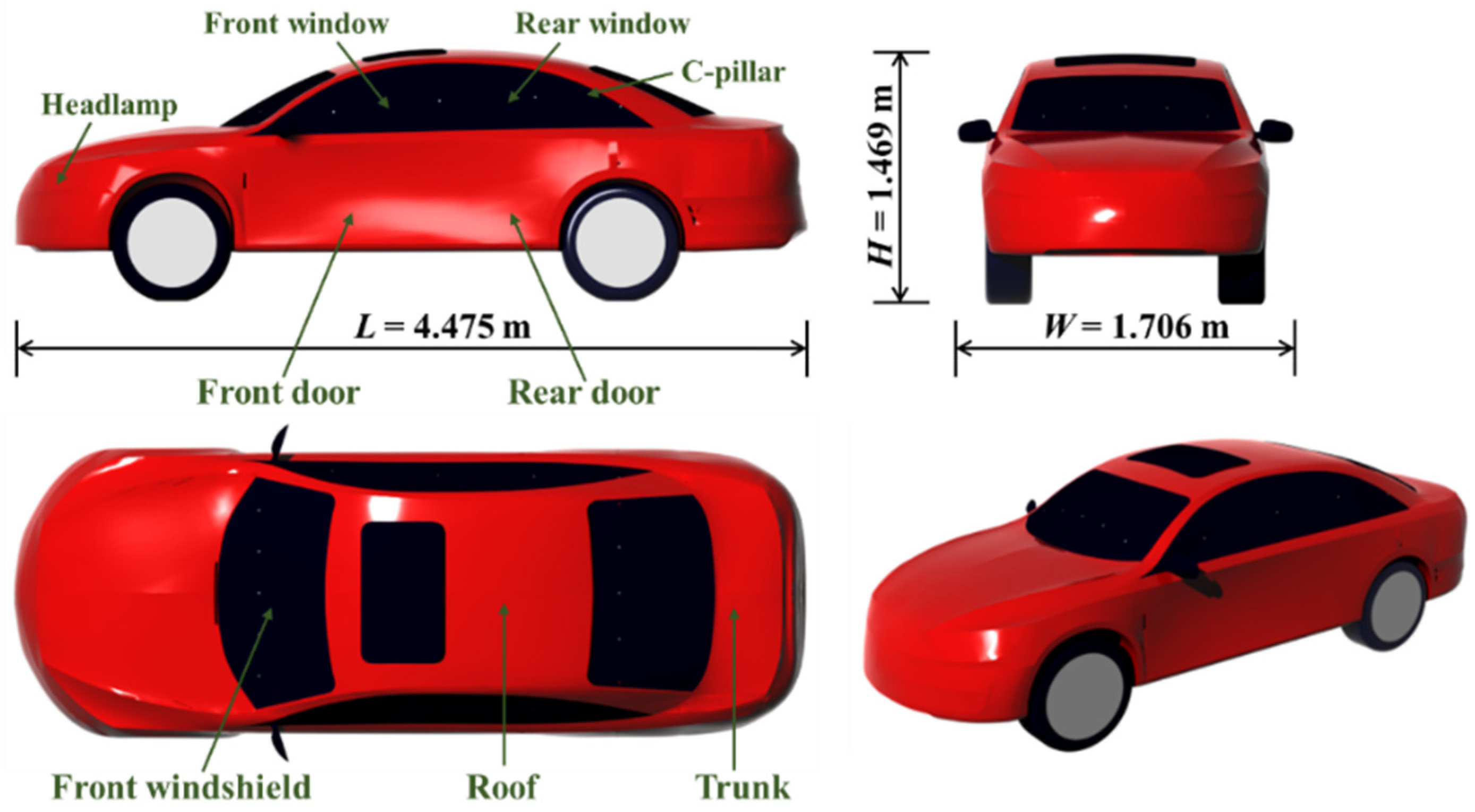
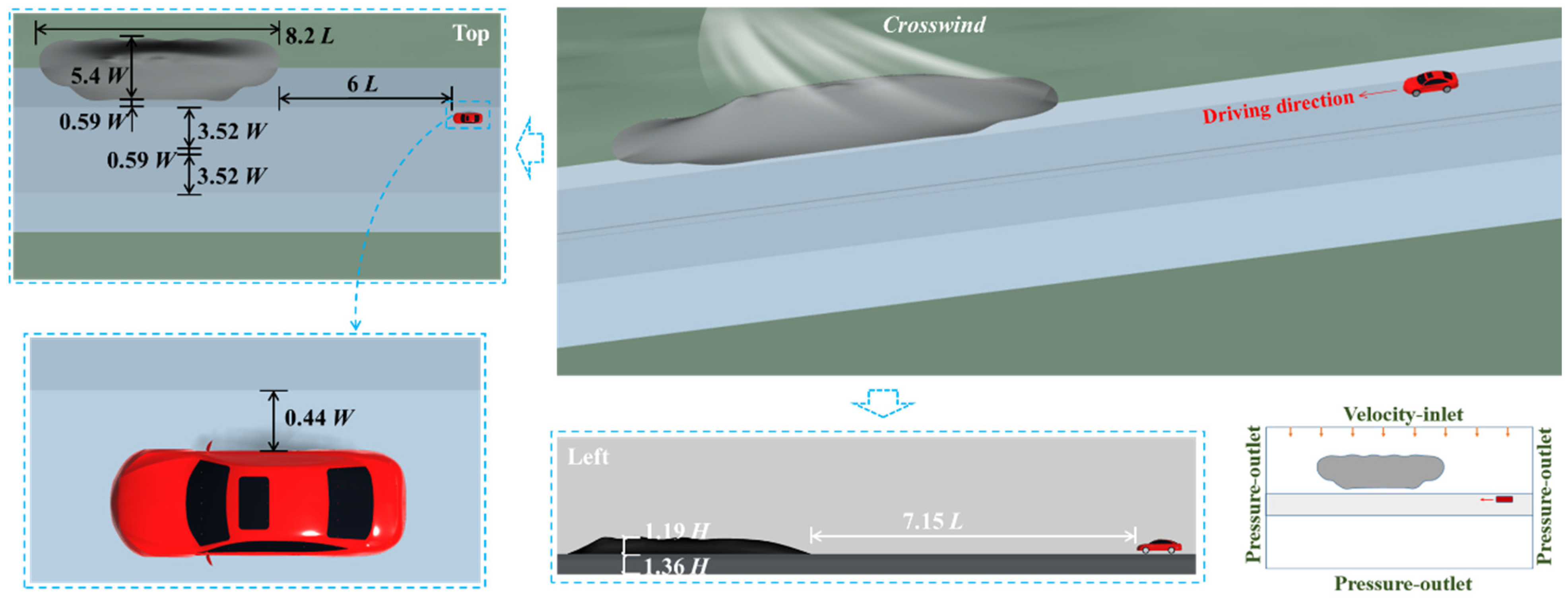
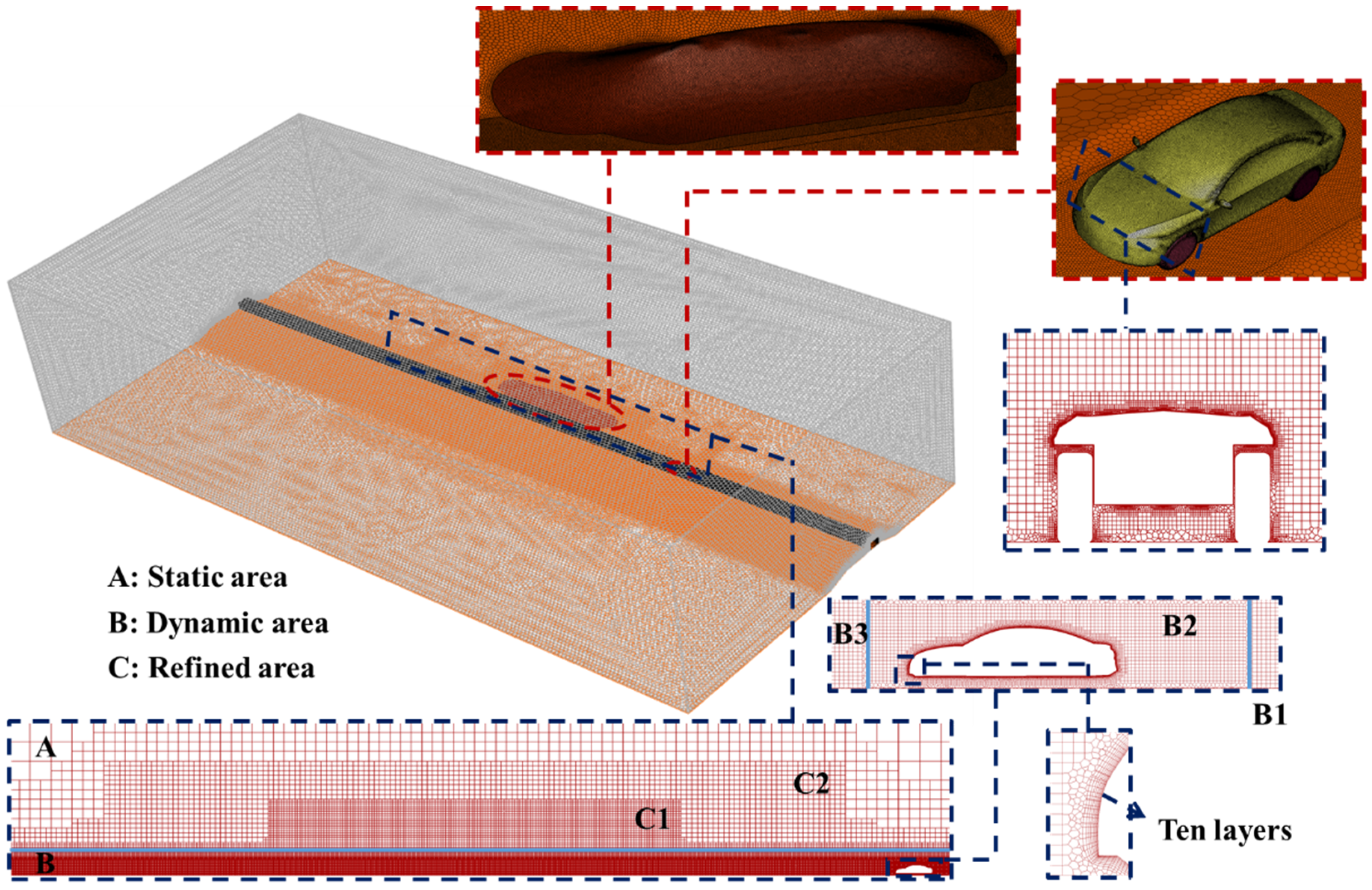
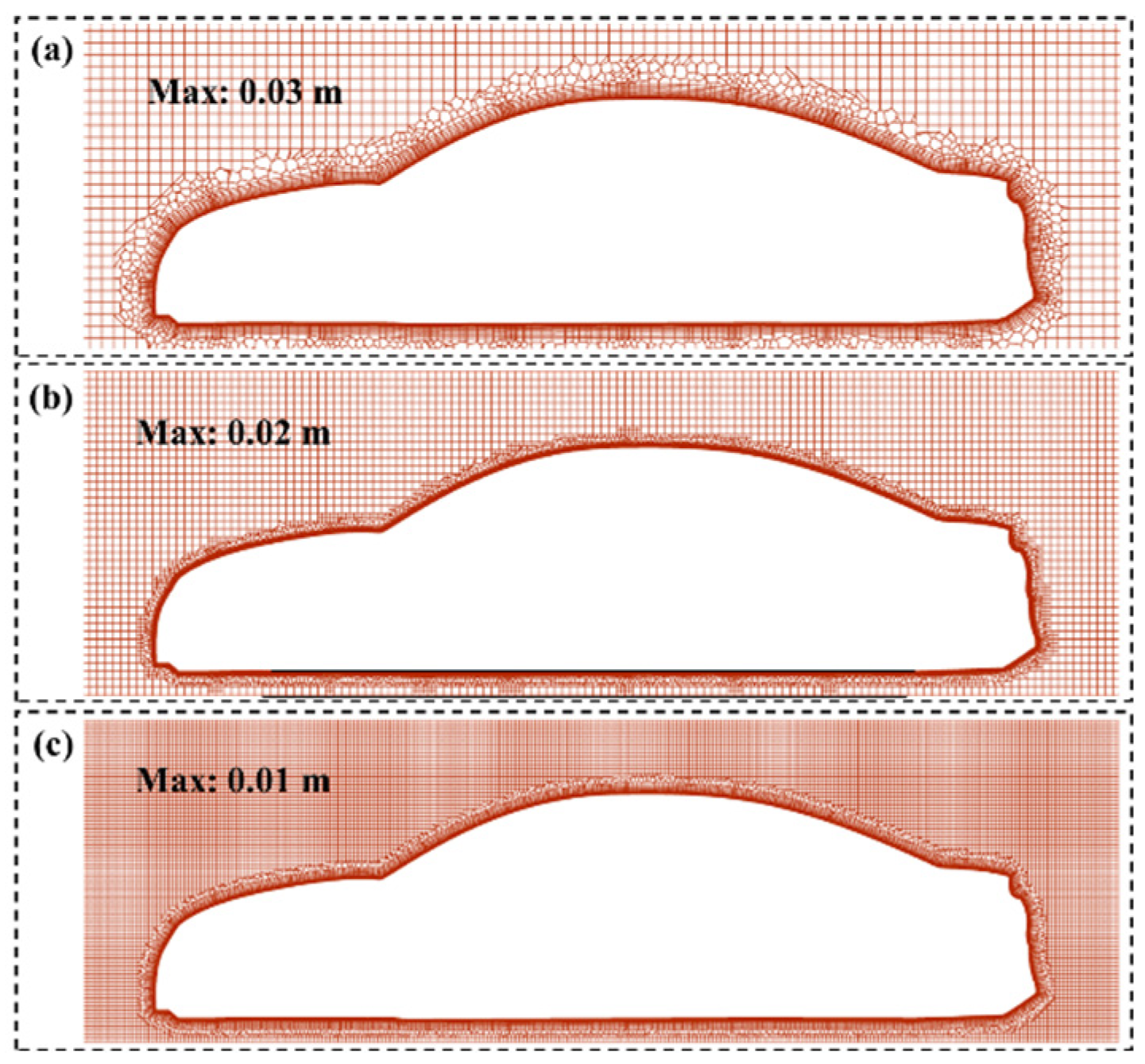

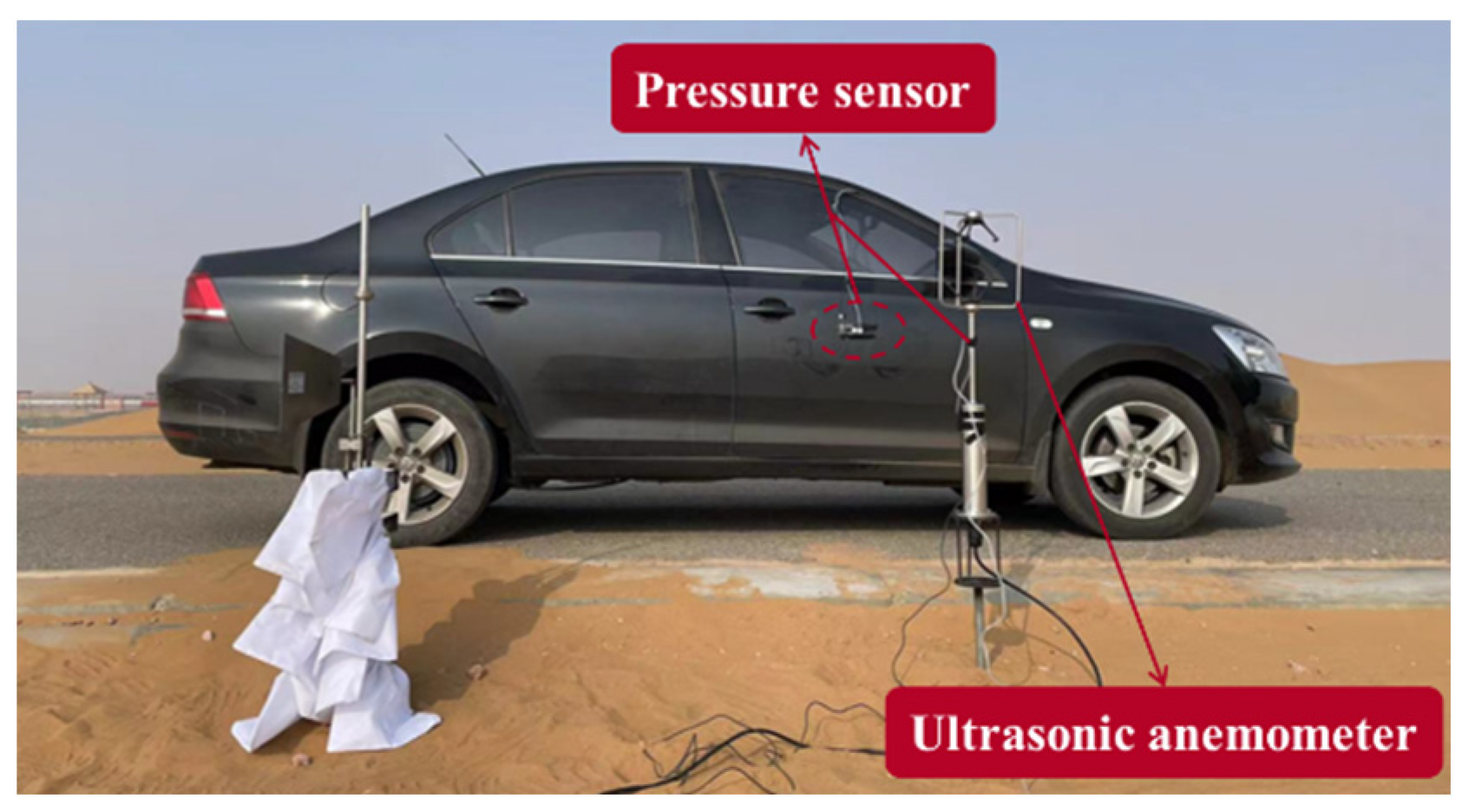


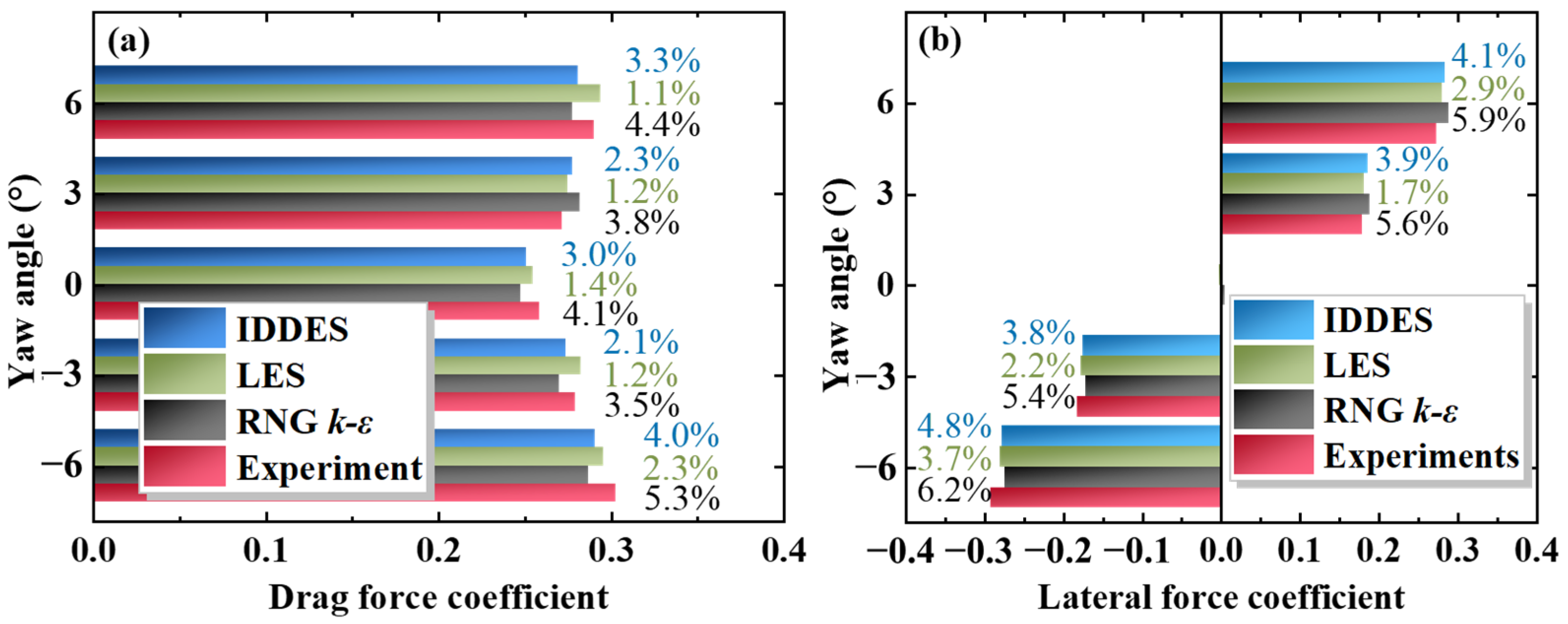
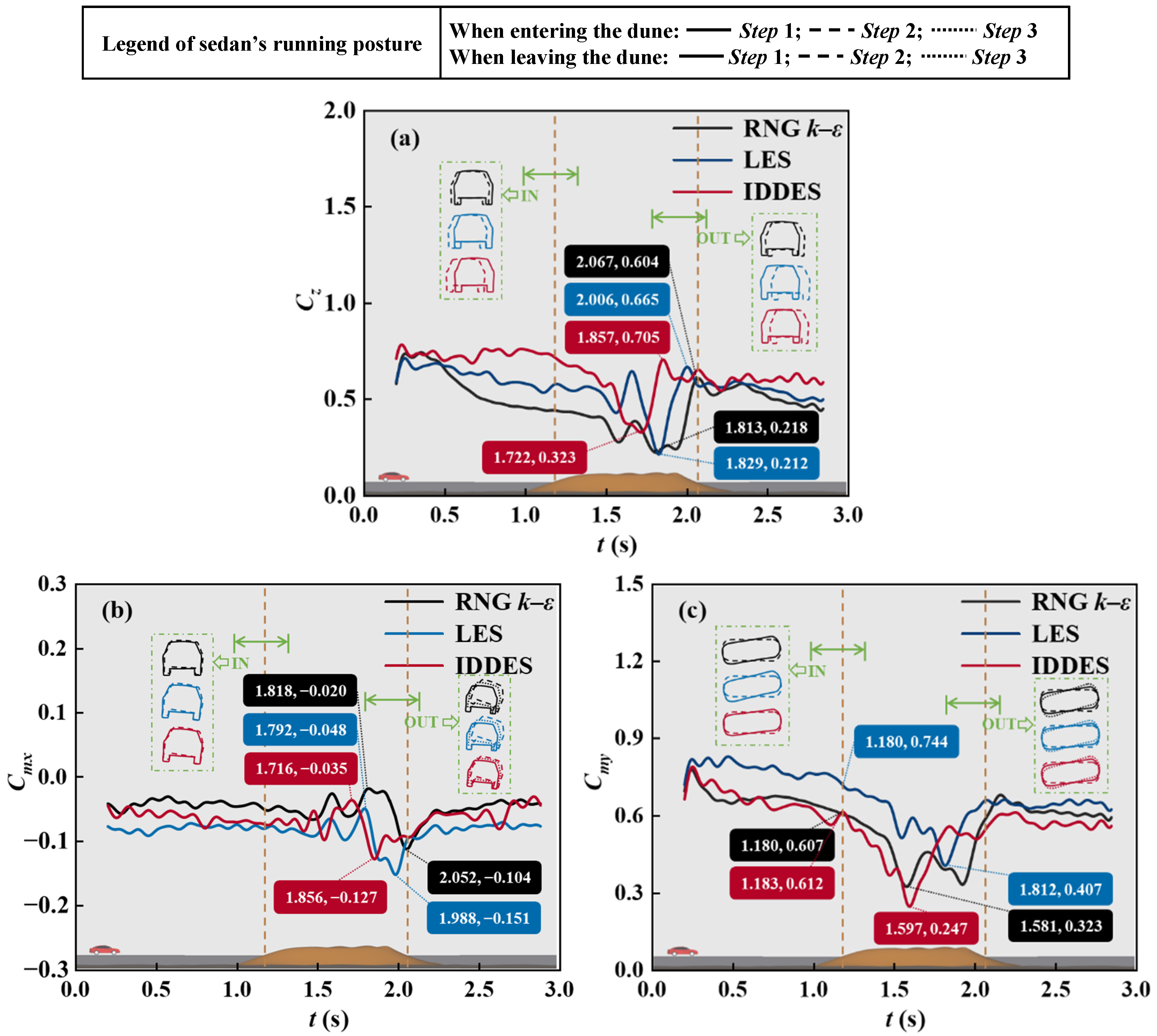
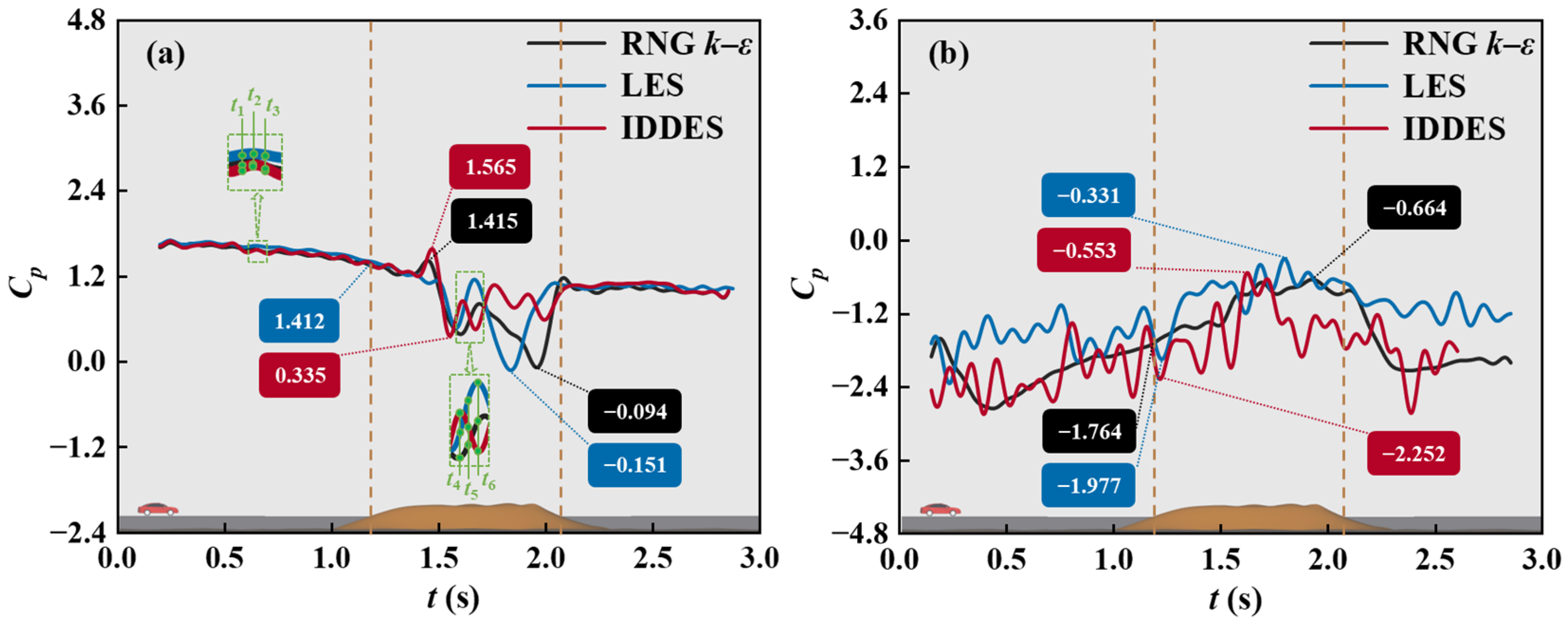
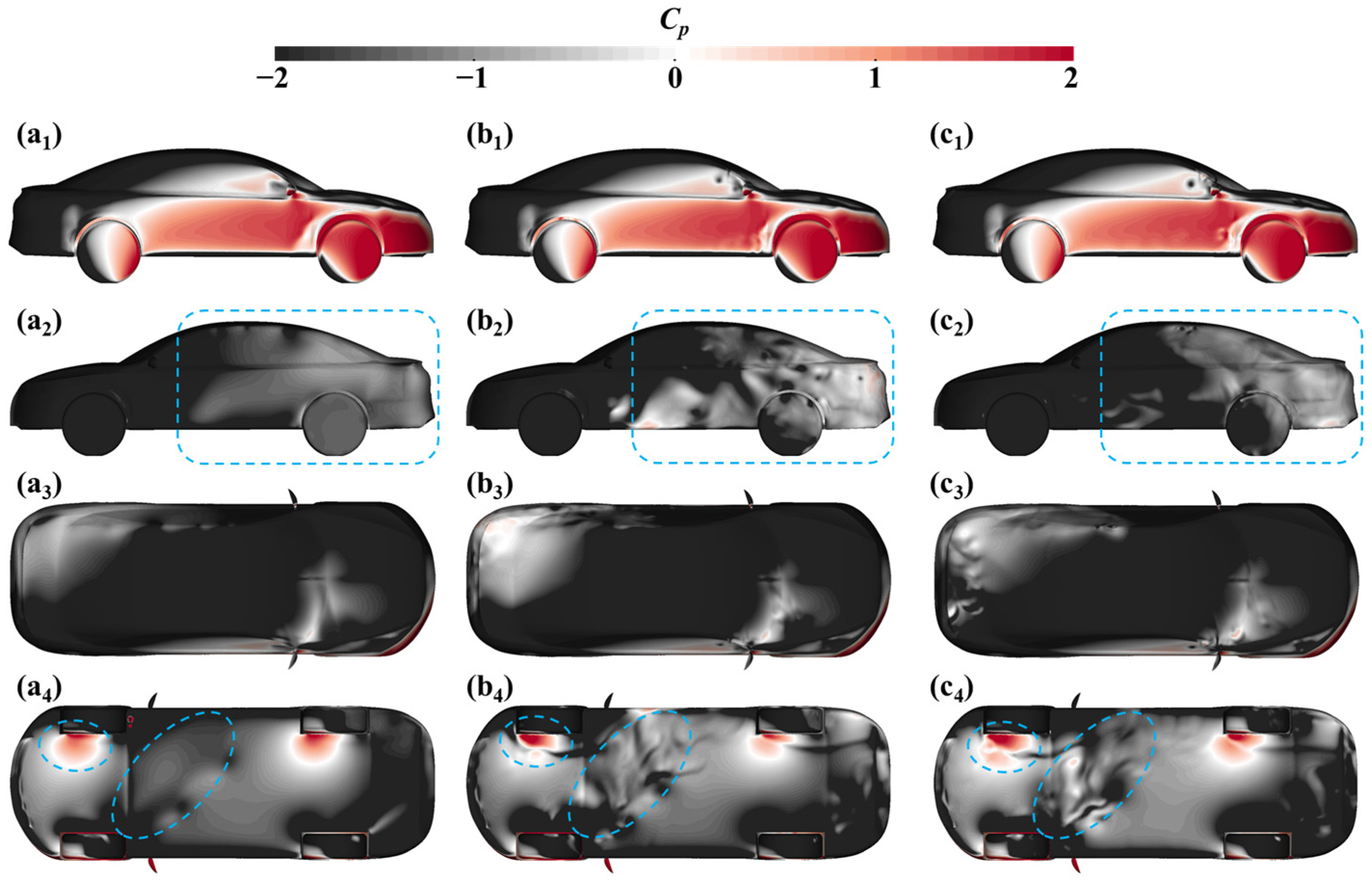
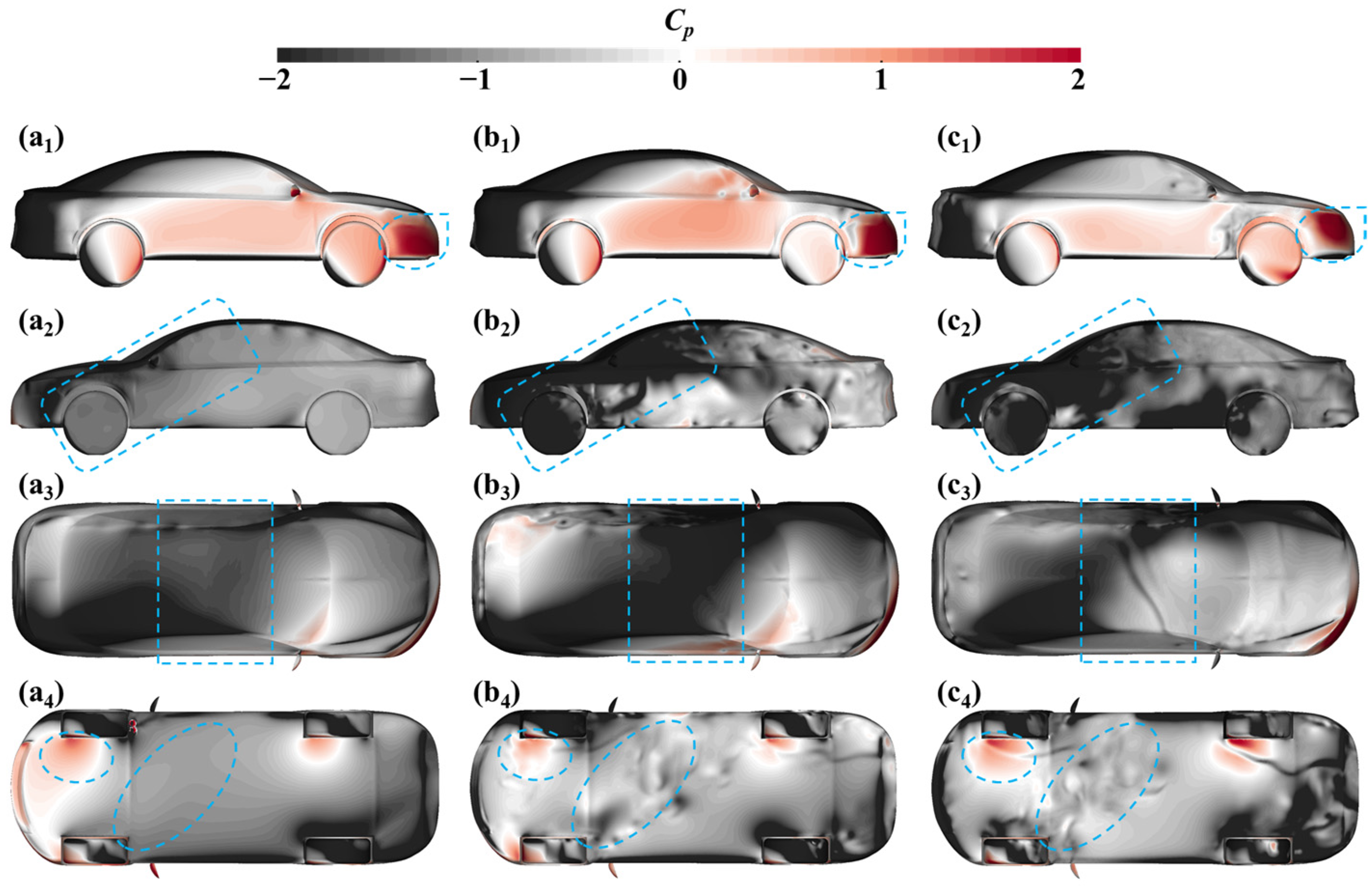

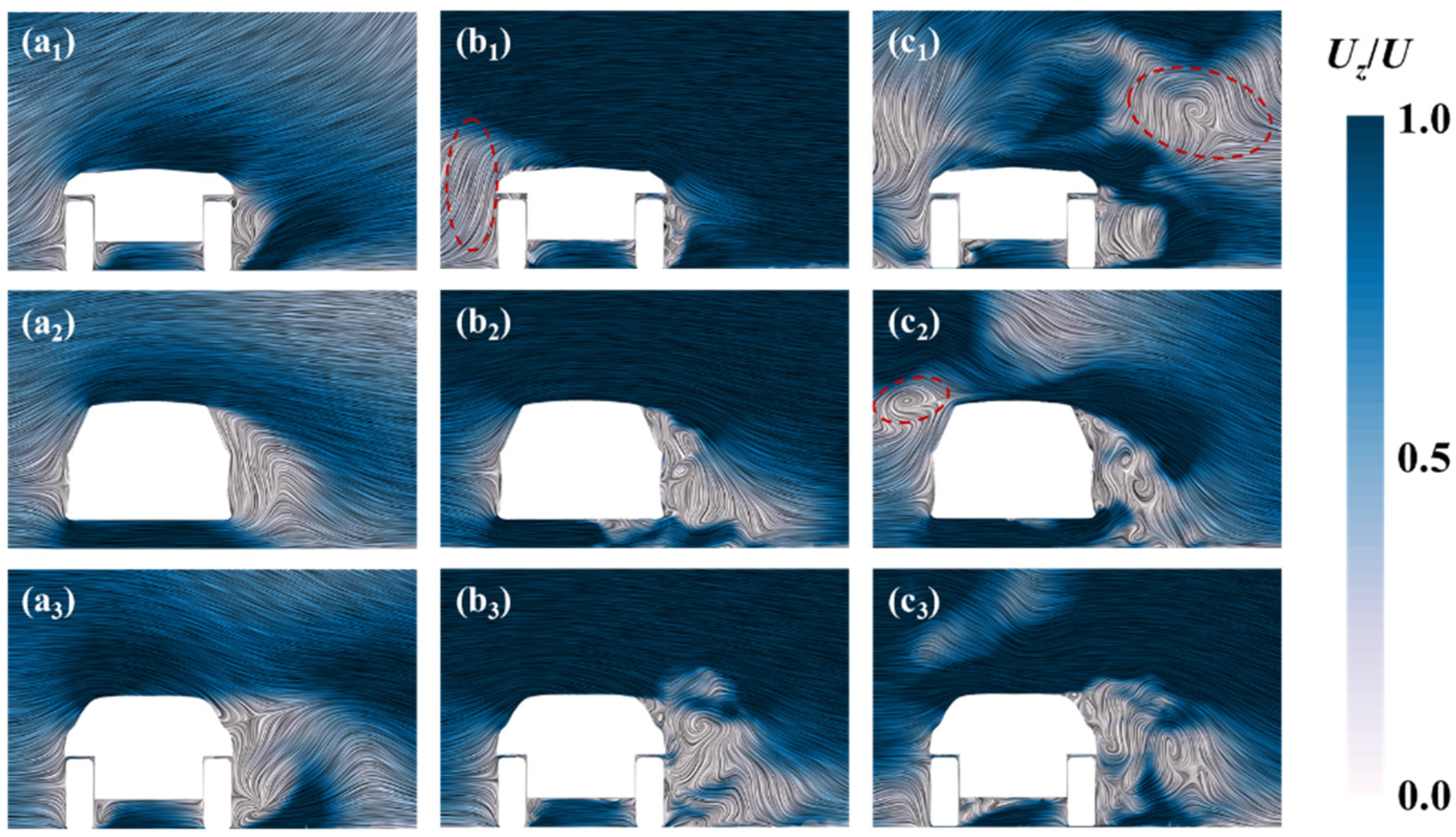
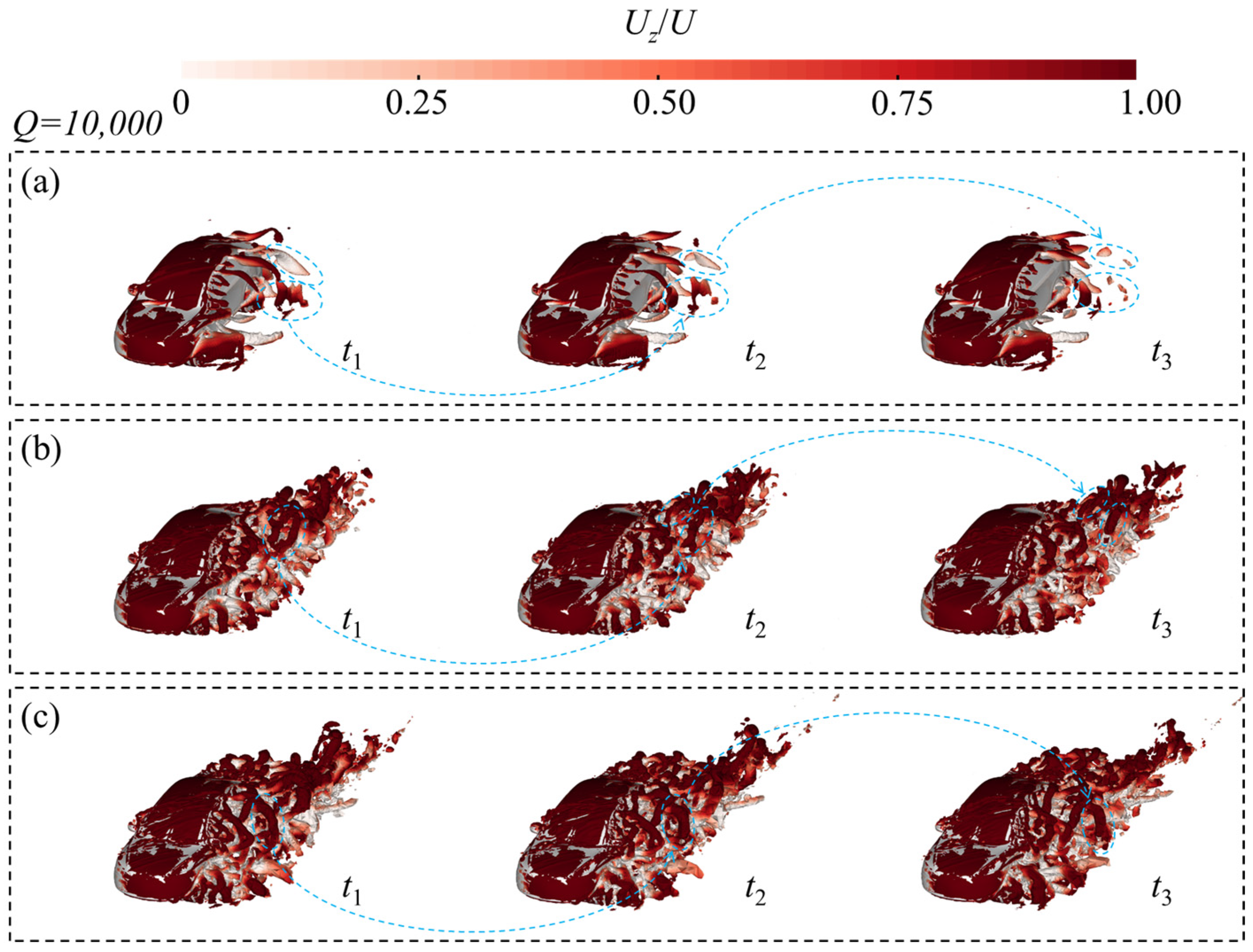
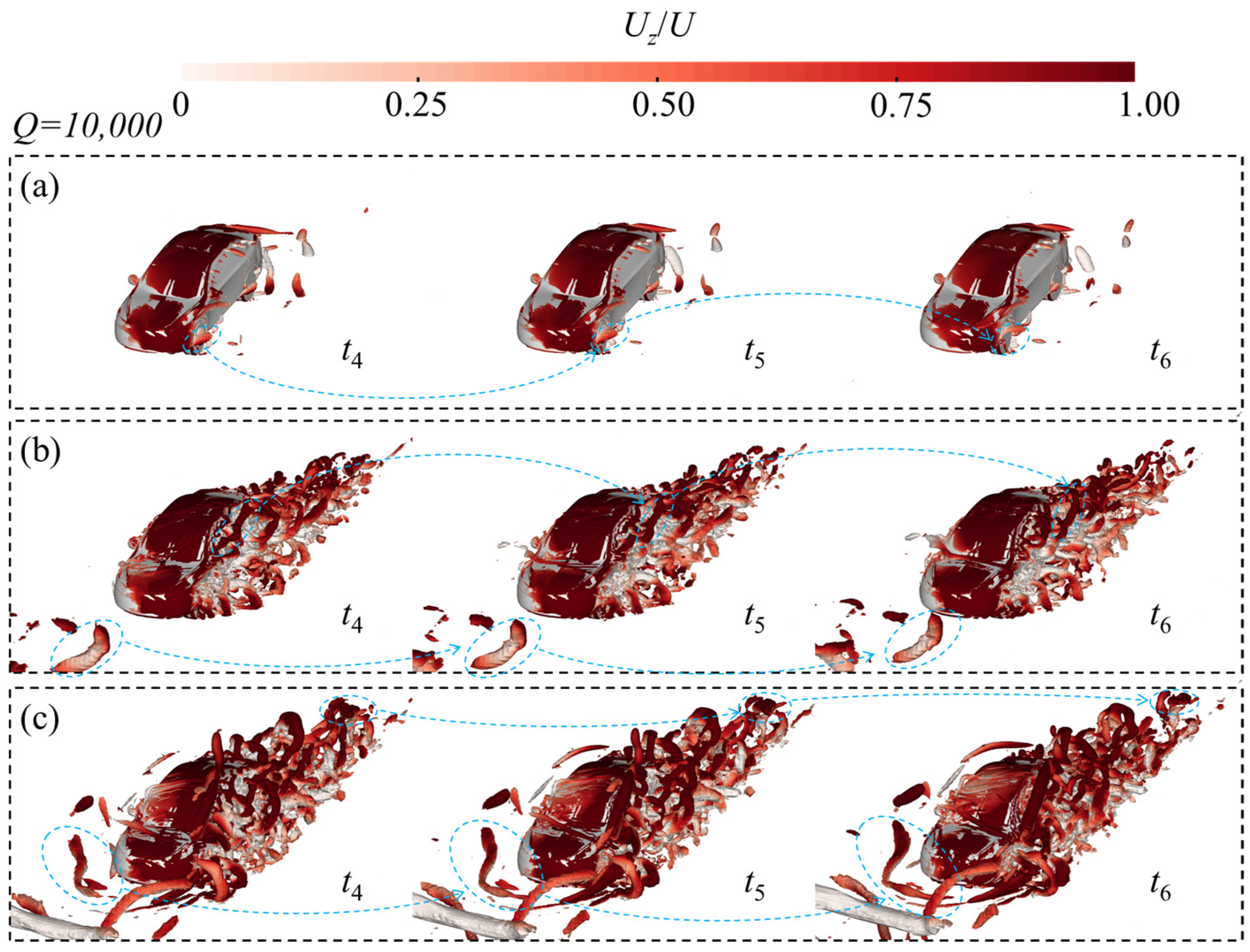


| Case | Turbulence Modeling Approaches | The Condition of the Flow Field | The Speed of the Crosswind (m/s) | The Driving Speed of the Sedan (m/s) | Calculation Time (h) |
|---|---|---|---|---|---|
| 1 | RNG k-ε | Crosswind | 20 | 27.78 | 127 |
| 2 | LES | Crosswind | 20 | 27.78 | 203 |
| 3 | IDDES | Crosswind | 20 | 27.78 | 141 |
| 4 | IDDES | Crosswind–sand | 20 | 27.78 | 165 |
| Turbulence Modeling Approaches | Aerodynamic Force | Cz | Cmx | Cmy |
|---|---|---|---|---|
| RNG k-ε | Max | 0.604 | −0.020 | 0.607 |
| Min | 0.218 | −0.104 | 0.323 | |
| Amplitude | 0.386 | 0.084 | 0.284 | |
| LES | Max | 0.665 | −0.048 | 0.744 |
| Min | 0.212 | −0.151 | 0.407 | |
| Amplitude | 0.453 | 0.103 | 0.337 | |
| IDDES | Max | 0.705 | −0.035 | 0.612 |
| Min | 0.323 | −0.127 | 0.247 | |
| Amplitude | 0.382 | 0.092 | 0.365 |
| Types of the Incoming Flows | Aerodynamic Force | Cz | Cmx | Cmy |
|---|---|---|---|---|
| Wind | Max | 0.705 | −0.035 | 0.612 |
| Min | 0.323 | −0.127 | 0.247 | |
| Amplitude | 0.382 | 0.092 | 0.365 | |
| Wind–sand | Max | 0.671 | −0.024 | 0.610 |
| Min | 0.257 | −0.115 | 0.297 | |
| Amplitude | 0.414 | 0.091 | 0.313 |
Disclaimer/Publisher’s Note: The statements, opinions and data contained in all publications are solely those of the individual author(s) and contributor(s) and not of MDPI and/or the editor(s). MDPI and/or the editor(s) disclaim responsibility for any injury to people or property resulting from any ideas, methods, instructions or products referred to in the content. |
© 2024 by the authors. Licensee MDPI, Basel, Switzerland. This article is an open access article distributed under the terms and conditions of the Creative Commons Attribution (CC BY) license (https://creativecommons.org/licenses/by/4.0/).
Share and Cite
Yang, W.; Wang, J.; Dong, Y. Effectiveness of Three Turbulence Modeling Approaches in a Crosswind–Sedan–Dune Computational Fluid Dynamics Framework. Appl. Sci. 2024, 14, 7522. https://doi.org/10.3390/app14177522
Yang W, Wang J, Dong Y. Effectiveness of Three Turbulence Modeling Approaches in a Crosswind–Sedan–Dune Computational Fluid Dynamics Framework. Applied Sciences. 2024; 14(17):7522. https://doi.org/10.3390/app14177522
Chicago/Turabian StyleYang, Weichao, Jian Wang, and Yue Dong. 2024. "Effectiveness of Three Turbulence Modeling Approaches in a Crosswind–Sedan–Dune Computational Fluid Dynamics Framework" Applied Sciences 14, no. 17: 7522. https://doi.org/10.3390/app14177522






